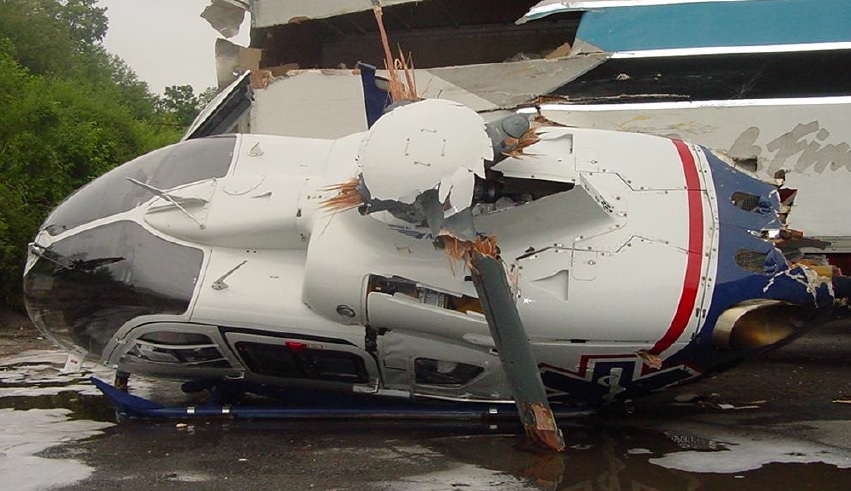Stabilised Hover Prevents Loss of Control Accidents Say FAA
The US Federal Aviation Administration (FAA) has issued Safety Alert for Operators SAFO 16016, Helicopter Stabilized Hover Checks Before Departure.
The FAA say that several recent occurrences had followed pilots:
…not bringing the helicopter to a stabilized hover before initiating takeoff. Rather, pilots elected to immediately and rapidly takeoff from the ground. In some cases, this has led to a [Loss of Control] LOC where the result was either an incident, or an accident resulting in significant damage to the helicopter and/or fatalities to those onboard.
Post-accident analysis indicated that the accident sequence began with indications that were evident when the helicopter was light on the skids, yet the pilot elected not to abort the takeoff by reducing collective. Instead, the pilot continued pulling in collective (or continued manipulating the controls) resulting in a complete LOC.
In one notable case:
One accident resulted from a pilot attempting a takeoff from the surface without completing a hover power check. As the aircraft lifted from a roof top helipad and over the edge of the rooftop, the aircraft lost altitude and crashed into a parking lot below. It was discovered that one of the two engines was in the “fly” position but the other engine was still in the idle position. If a hover check was performed before takeoff, this accident could have been prevented.
While the NTSB don’t identify which accident they refer to, it appears to be an accident involving a HEMS Airbus Helicopters EC135P2+ N238AM operated by Air Methods Corporation on 30 May 2008 in Pottsville, PA. The NTSB report says:
After taking off… the twin-engine helicopter climbed approximately 75 feet. The pilot lowered the nose, but the helicopter would not climb or accelerate normally… The pilot also noticed that one torque indication was declining to “near zero” percent, and the helicopter began to yaw. The pilot was able to correct the yawing moment with anti-torque inputs, and remembered lowering the collective and “pulling pitch” before the helicopter impacted the ground in a level attitude. The No. 1 engine was running as the pilot exited the helicopter, but the No. 2 engine was not.
Examinations at the accident site revealed that the helicopter, after lifting off from the heliport, flew out of ground effect over down-sloping terrain, settled, then struck a parked semi-trailer about 80 feet below the heliport.
Air Methods HEMS EC135P2+ N238AM Wreckage at Pottsville, PA, After Take Off with One Engine at Idle from an Elevated Helipad (Credit: NTSB)
As part of the pre-takeoff confirmation check, the pilot was required to ensure that both main engine switches were in the FLIGHT position; however, onboard recorded data revealed that the No. 2 main engine switch was in the IDLE position during the takeoff.
The National Transportation Safety Board determines the probable cause(s) of this accident as follows: The pilot’s failure to ensure that both engine switches were in the FLIGHT position for takeoff.
After that accident the Type Certificate Holder issued a safety alert, noting that the high OEI power of the EC135 can be sufficient for the aircraft to take off. There was a SAFO issued in 2006 after that accident.
We suspect however the SAFO has really been prompted by a couple of recent accidents were take offs have been made with incorrect hydraulic switch settings.
The FAA recommendations include:
Using strict discipline and without compromise…an appropriate checklist.
Unless prohibited by environmental conditions such as the possibility of whiteout, brownout, etc, always perform a hover check prior to takeoff.
When performing a vertical takeoff, raise the helicopter vertically from the surface to a normal hovering altitude (2 to 3 feet) with minimal lateral or longitudinal movement maintaining a constant heading. If at any time during initial collective pull the helicopter does not appear to be stabilized, ABORT the takeoff by smoothly reducing the collective.
The FAA had also issued yet another SAFO, in 2008, on Preflight check of helicopter hydraulic systems to include validation of control movement smoothness and identification of adverse flight control “stick-jump”. This followed the loss of Copterline Sikorsky S-76C+ OH-HCI off the coast of Estonia.
Safety Resources
Aerossurance has previously written on these associated topics:
- James Reason’s 12 Principles of Error Management
- Back to the Future: Error Management
- Time Pressures and Take-Off Trim Trouble
- EC120 Forgotten Walkaround
- Flawed Post-Flight and Pre-Flight Inspections Miss Propeller Damage
- Too Rushed to Check: Misrigged Flying Controls
- When Habits Kill – Canadian MD500 Accident
- Troublesome Tiedowns
- Troublesome Tiedowns: The Sequel
- UPDATE 25 April 2020: Fatal R44 Loss of Control Accident: Overweight and Out of Balance
- UPDATE 9 October 2021: Gazelle Caught Out Jumping a Fence
- UPDATE 30 October 2021: RLC B407 Reverses into Sister Ship at GOM Heliport
Also see our review of The Field Guide to Understanding Human Error by Sidney Dekker presented to the Royal Aeronautical Society (RAeS): The Field Guide to Understanding Human Error – A Review



Recent Comments